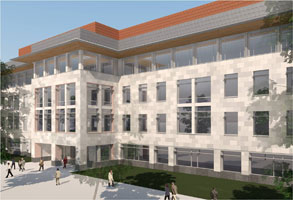 Last year, Fred Hutchinson Cancer Research Center in Seattle acquired a newly-constructed 177,000 sf building adjacent to its campus on South Lake Union for $36Million. The complicated business of moving all of the Vaccine and Infectious Disease Division (VIDD) labs and faculty from their current building(s) into the new space is scheduled for June of 2012. While there will be an overall increase in lab square footage, the main advantages of the relocation involve building quality, location, and financial benefits.
Last year, Fred Hutchinson Cancer Research Center in Seattle acquired a newly-constructed 177,000 sf building adjacent to its campus on South Lake Union for $36Million. The complicated business of moving all of the Vaccine and Infectious Disease Division (VIDD) labs and faculty from their current building(s) into the new space is scheduled for June of 2012. While there will be an overall increase in lab square footage, the main advantages of the relocation involve building quality, location, and financial benefits.
Tags: Fred Hutchinson Cancer Research Center, Washington, Northwest, cancer research, New research facilities, Event
 The University of Pittsburgh Medical Center (UPMC) recently released a quarterly financial report that showed solid growth for Western Pennsylvania's largest health care provider and one of the largest nonprofit health systems in the US. It also announced that it will be begin construction on a $300M facility to house its nascent Center for Innovative Science, which "will bring together leading scientists willing to develop bold, new approaches to understanding complex diseases," according to UPMC's president. In conjunction with its academic partner, the University of Pittsburgh, UPMC is already recruiting nationally for "a scientific leader in genetics and genomics" to head the center.
The University of Pittsburgh Medical Center (UPMC) recently released a quarterly financial report that showed solid growth for Western Pennsylvania's largest health care provider and one of the largest nonprofit health systems in the US. It also announced that it will be begin construction on a $300M facility to house its nascent Center for Innovative Science, which "will bring together leading scientists willing to develop bold, new approaches to understanding complex diseases," according to UPMC's president. In conjunction with its academic partner, the University of Pittsburgh, UPMC is already recruiting nationally for "a scientific leader in genetics and genomics" to head the center.
Tags: University of Pittsburgh, Northeast, Aging, cancer research, New research facilities, UPITT, BioResearch Product Faire Event, Genomics, PA, Pittsburgh
Following up on our much-read April 2011 blog on Biomedical Building News at UCSD, we are pleased to report that the following UCSD medical facilities have celebrated their grand openings:
Tags: CA, biomedical research, Stem cell research, New research facilities, new science wet labs, Southwest, 2012, San Diego, SDVS, Genomics, UC San Diego, LEED, Biotechnology Vendor Showcase Event, 2011
When the Bio5 Institute's new building opened in 2007 north of Speedway on the University of Arizona (UA) campus in Tucson, it signalled a new period of growth and innovation that would link the UA Medical Center with interdisciplinary biomedical and life science research on the main UA campus. The Bio5 building, also known as the Thomas W Keating Bioresearch Building (and formerly named the Institute for Biomedical Sciences & Biotechnology [IBSB]) is "a high-tech laboratory facility supporting interdisciplinary molecular life sciences research."
Tags: University of Arizona, New research facilities, Southwest, BioResearch Product Faire Front Line Event, Arizona, AZ, UAZ, Research, Tucson, 2011
Tags: Northeast, New research facilities, New York, Stony Brook University, Neuroscience, New York City
Tags: Biomedical expansion, New research facilities, Texas Medical Center, Southwest, 2012, tmc, BioResearch Product Faire Event, Houston, TX
When Merck bought Sirna in 2006, the pharmaceutical giant took over Sirna's San Francisco Mission Bay research space at 1700 Owens St. and became the first major life science company to move into the up-and-coming biotech hub. Except, of course, for biomedical research megastar University of California, San Francisco, which opened the first building of its Mission Bay Campus in 2003 and currently houses its Biochemistry & Biophysics Departments in Genentech Hall, Byers Hall and Rock Hall. Also on the bayside campus are the William J Rutter Conference Center, Smith Cardiovascular Research Building, UCSF Housing, a child care center, the Helen Diller Family Cancer Research Building, the Orthpaedic Institute, and retail shops. UCSF's real estate holdings at Mission Bay total 57 acres, and the University currently employs over 2000 people at the MB campus alone (before the opening of the future medical center complex and the new Neurosciences Laboratory and Clinical Research Building).
Tags: University of California San Francisco, New research facilities, California, biotech industry, research laboratories, new construction, Mission Bay Campus
 The $62.5 million Linus Pauling Science Center on the corner of 29th and Campus Way in Corvallis, Oregon, is having its grand opening on Friday, October 14, 2011. The new 105,000-square-foot building will house the Linus Pauling Institute, chemists from the College of Science, and contain classroom and laboratory space for students and researchers studying chemistry, biology, and the life sciences. It is the largest donor-supported building project in the history of Oregon State University. In addition to providing building funds, some 2,600 other donors have made gifts totaling more than $21 million to support the educational and research programs that will be housed in the building.
The $62.5 million Linus Pauling Science Center on the corner of 29th and Campus Way in Corvallis, Oregon, is having its grand opening on Friday, October 14, 2011. The new 105,000-square-foot building will house the Linus Pauling Institute, chemists from the College of Science, and contain classroom and laboratory space for students and researchers studying chemistry, biology, and the life sciences. It is the largest donor-supported building project in the history of Oregon State University. In addition to providing building funds, some 2,600 other donors have made gifts totaling more than $21 million to support the educational and research programs that will be housed in the building.
Tags: Oregon State University, Northwest, New research facilities, Oregon, Happy scientist

San Antonio is about to celebrate the opening of a major new science research building: the STRF, or South Texas Research Facility on the campus of the University of Texas Health Science Center. The 190,000sf state-of-the-art research facility is stretched over only three floors, so the building is low and long: 1000 feet long. If you tipped over the Eiffel Tower...well, you get the idea. UTHSCSA started planning the new lab and office space three years ago when it became clear that their research faculty was growing at a healthy rate, but their facilities were not keeping up. When it is fully occupied, the STRF will house 350 faculty and staff members. Plans are to fill 60% of the building with current faculty and their research teams and to use the remaining space for new recruits, specifically 15 to 20 top scientists and their associates to be brought on board.
The four core programs moving to the STRF are:
Tags: Stem cell research, cancer research, New research facilities, Texas, Southwest, UT Health Science Center San Antonio, Neuroscience

Emory University continues to expand its capacity for medical research and care as it begins construction on a new building dedicated primarily to pediatric care. The new facility is envisioned as a partnership between Children's Healthcare of Atlanta and Emory as well as other Atlanta-area institutions such as the Georgia Institute of Technology and the Morehouse College School of Medicine.
Speaking about the new facility, S. Wright Caughman, M.D. and CEO of the Woodruff Health Sciences Center, argued "This partnership will lead to continued medical advances that will benefit pediatric and adult patients in Georgia and throughout the world and will help Emory and Children's reach the top ranks of pediatric research institutions."
Tags: Emory University, Southeast, New research facilities, Georgia


